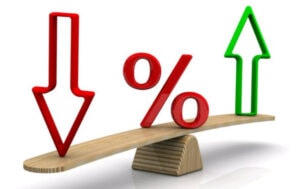Surging bond yields and the sharply rising dollar kept the bears engaged Tuesday in a painful selloff that added to the technical damage of the index charts. The T2122 indicator is in an extreme short-term oversold condition suggesting a relief rally could begin at any time. However, bond yields are still rising this morning with a parade of Fed speakers today, adding to the uncertainty. Investors will look for inspiration in Mortgage, ADP, PMI, Factory Orders, ISM Services, and Petroleum Status figures as well as a handful of notable earnings reports today. Expect the price action to remain challenging as we head toward the Friday, Employment Situation report.
Asian markets were mostly lower overnight as Australia kept interest rates unchanged with China closed for a holiday. European markets are however working to relieve the recent selling pressure with modest gains this morning in a cautious session. U.S. futures recovered from overnight lows pointing to a modestly bullish open ahead of earnings and economic data that could provide fuel to the bulls or bears so plan your risk carefully.
Economic Calendar


Earnings Calendar

Notable reports for Wednesday include ANGO, HELE, RGP, RPM, & TLRY.
News & Technicals’
The U.S. bond yields surged higher on Wednesday, as investors were worried about the possibility of the Fed keeping the interest rates high for a longer period than expected. The Fed’s interest rate policy affects the bond yields, which are the returns that investors get from buying bonds. The higher the interest rates, the lower the bond prices and the higher the bond yields. The Fed has been raising the interest rates since 2015, to control inflation and support economic growth. The Fed’s latest meeting in September signaled that it may raise the interest rates one more time this year and three more times next year. This has caused the bond yields to rise to their highest levels in more than a decade. The 10-year Treasury yield, which is the most widely watched indicator of the bond market, was slightly up at 4.81% on Wednesday. It had reached a high of 4.884% earlier in the day, after crossing the 4.8% mark on Tuesday for the first time since 2007. The 30-year Treasury yield, which is another important indicator of the bond market, was slightly down at 4.934% on Wednesday. It had briefly traded above 5% earlier in the session, also reaching levels last seen in 2007.
The United Nations Conference on Trade and Development (UNCTAD) has released a new forecast for global economic growth in 2024. The forecast predicts that the world economy will grow by 2.5% in 2024, slightly higher than the 2.4% growth in 2023. However, the forecast is based on several assumptions and uncertainties, and UNCTAD warns that the growth outlook is fragile and uneven. UNCTAD is particularly cautious about the U.S. economy, which is expected to slow down from 3.1% in 2023 to 2.1% in 2024, due to the fading effects of the fiscal stimulus and the rising interest rates. A UN director told CNBC that the forecast is “optimistic” given the “pretty weak” state of the global economy. He said that the main risk for global growth is the eurozone, which is on the verge of a recession. The eurozone is expected to grow by only 0.9% in 2024, after a meager 0.7% in 2023. UNCTAD urges the eurozone to adopt more expansionary fiscal and monetary policies and to address the structural problems of its banking sector and its trade surplus.

ntel, the world’s largest chipmaker, announced that it will spin off its Programmable Solutions Group (PSG) as a separate business, with the intention of taking it public in the next two to three years. PSG is the division that makes programmable chips, also known as field-programmable gate arrays (FPGAs), which can be customized for specific applications. Intel acquired PSG in 2015 when it bought Altera for $16.7 billion. Intel said that it will continue to support PSG and will retain a majority stake in the business, but it will give PSG more autonomy and flexibility to pursue its growth strategy. Intel’s stock price rose by 2.3% in after-hours trading following the announcement.
The stock market dropped sharply on Tuesday, as the bond yields and dollar kept rising as investors now seem to be aware that rates will be higher longer as the Fed has been saying. The S&P 500 fell by more than 1% and the Dow lost over 400 points. The sectors that did better were the ones that provided essential goods and services, such as utilities and consumer staples. The sectors that did worse were the ones that depended on innovation and spending, such as technology and consumer discretionary. Today we have ADP, PMI, Factory Orders, ISM Services, Petroleum Status, and a slew of Fed speakers to provide inspiration and volatility in the extreme short-term oversold condition. Although we have a few notable earnings it’s unlikely they will market-moving so instead keep an eye on those bond yields that are continuing to rise this morning. A relief could begin at any time but if bad data continues to pile on be prepared for more selling, whipsaws, and challenging price volatility.
Trade Wisely,
Doug








Comments are closed.